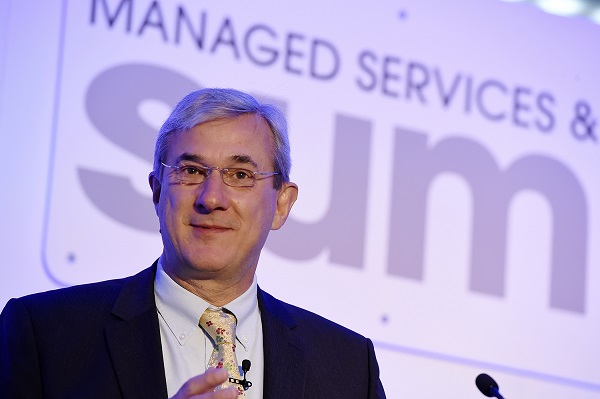 An important list of questions for MSPs planning future growth, from Gartner presentation at the Managed Services Summit
An important list of questions for MSPs planning future growth, from Gartner presentation at the Managed Services Summit Managed services may not deliver growth in its own to the MSP unless they expand their offerings, warns Mark Paine of Gartner. Speaking at the Managed Services and Hosting Summit in London on September 21, he has common themes with other presenters, but emphasised that he had never seen so much change in 25 years in the industry.

“Customers have started a journey on digital transformation, but you have to change further and become a valued partner. Provisioning is just the start, and there are some options.” The move to MSP is a roller coaster even recognising the long term trends.
Competition is fierce: research shows some $256bn of opportunity, but there will be 100,000 MSPs by 2018, and using the 80/20 rule means that there will be little left over for the bulk of the MSPs, he explained. “There will be winners and losers, as in any emerging service. The real secret source is to have and keep lifetime customers. If you have to drive more toward new customers, this is not good for acquisition costs.”
There is no time to sit back – the Gartner CIO survey showed that the customers are asking for less support with consulting, implementation and management. This means that MSP growth will have to be through gaining more customers. The customer journey to become more agile will need the MSP to follow this and lead where possible.
The customers are looking for a cut in IT costs by moving to cloud – just 14% in the Gartner survey said this, however. The next stage is realign the budgets with IT projects to improve operation efficiency. 80 of CIOs say that digital transformation is the key priority – helping them with their own customer experiences. Stage two is of course where the customers need help – once they have made the choice and moved to managed services, there is a continuing drive to operational efficiency and customer centricity.
“If you don't follow the customer journey, the research shows that customers will find other partners. Many enquiries from mid-market clients in particular show that they are confused and perplexed by the lack of services being offered by incumbent suppliers,” he explained There is a shortage of cloud migration skills, and as customers change, they can run ahead of existing suppliers.
All this makes it harder for the MSP – the results of the CIO survey shows where they are now – in stage one they look for pricing and service, stage two means looking for more – helping them through the transformation. Stage three is to keep in improving agility and outcomes.
By 2017 half of all customers will have digital businesses, rising to 83% in two years' time. This is made up from Cloud for business which is a big part of this, as is IoT and then algorithmic business driving outcomes.
“Customers want you to take the cloud services and help them speed up their businesses. This also helps you build life-time customers, but the catch is that many of these cloud projects are short term – a fact which has hit some of the larger global integrators quite hard. It takes time to become a trusted advisor, however, with pro-active support.”
IoT sounds wonderful – with smart devices- and is a great way to improve operational efficiency. Managed services is an important part and adds value to MSPs. But it is a lot more than getting things out there and the networks to support them – it is about the data. MSPs have a number of options to support IoT, but all require expansion of services, he says. Algorithmic business means taking the data and the devices and turning them into measurable returns. The catch is that it requires skills and and understanding of the business processes.
Digital business is very vertically focused – the public sector using smart cities; retail and the connected store; manufacturing and production line optimisation are just a few of these; transportation.
Mark Paine then outlined the sorts of questions MSPs need to ask themselves: starting with core services: who is your ideal customer and which services do they like most?
“Out of the trends, where do you fit, based on skills, wins and customer fit? What complementary services can you deliver? If I can't deliver them, then who do I partner with? Or do I build or acquire the skills?”
Build the vision for where you want to be and think about how to partner, build or buy. The digital business ecosystem is quite complex, and pivots around industry standards, customers markets, and around the major technology providers. Building your own alternative requires a lot of resources.
Reinforce the customer approach with lifecycle management, always asking what more can be sold, he concluded.
Learn more about the next Managed Services event - Amsterdam, December 2016 here
For more information contact alan.norman@ITEuropa.com 01895 454558